Who Controls the User Experience? AMD’s Carrizo Thoroughly Tested
by Ian Cutress on February 4, 2016 8:00 AM EST#4 The HP Pavilion 17z-g100 (Carrizo, A10-8700P)
Of the group, the HP Pavilion sits as the larger screen, medium range hardware component with a similar sort of finesse to the Elitebook, albeit at a much lower price point. This 17-inch model was certainly heavy, suggesting that it is more aimed at that desktop replacement or mobile office group of users who want a large screen, although this one was also a 1366x768 TN panel, which pushes down the sticker price.
| HP Pavilion 17z-g100 (Carrizo) Specifications | |
| Size and Resolution | 17-inch, 1366x768 TN with Touch |
| Processor | AMD A10-8700P Dual module, 4 threads 1.8 GHz Base Frequency 3.2 GHz Turbo Frequency |
| Graphics | Integrated R6 384 Shader Cores 800 MHz maximum frequency GCN 1.2 |
| TDP | 15W |
| Memory | 8 GB in Single Channel Operation 1 x 8GB at DDR3L-1600 C11 Dual Channel Capable |
| Storage | 1TB HGST HDD |
| Battery Size | 41.113 Wh 4 cell Li-Ion design |
| WiFi | Realtek RTL8723BE 802.11n 1x1 |
| Optical Drive | Yes |
| Dimensions | 16.49 x 11.29 x 1.12-inch |
| Weight | From 6.84 lbs |
| Webcam | 1280x720 |
| Ports | Memory Card Reader HDMI 2 x USB 3.0 + 1 x USB 2.0 10/100 Ethernet |
| Operating System | Windows 10 Home |
This unit was purchased especially for our testing (it turns out there’s a Best Buy around the corner from AMD HQ), and comes in low on the hardware all around. Aside from the screen, the A10-8700P processor comes mid-stack of the Carrizo parts, with a 1.8 GHz base and 3.2 GHz turbo frequency for the dual module/quad thread design. The integrated graphics rings in at 384 streaming processors, or 6 compute units, running at 720 MHz.
Memory and storage are at the base level, going for a single module of 8GB (meaning single-channel memory operation) and a 1TB HGST mechanical hard-drive. The Pavilion is dual channel capable though, which would be my first port of call for an upgrade. The Wi-Fi is also bargain basement, being a single stream 802.11n solution in the Realtek RTL8723BE.
There has to be some upsides to this, right? Assuming low power everything, low resolution display, large heavy design with a big battery? Our light battery life test clocked in at 5.43 hours, or 326 minutes, meaning that some of the hardware here is only here because it needs to hit a price point.
The Design
Aside from the specifications, the Pavilion has a good look to it.
Aside from the outside of the chassis at the top of the page, the insides give a near-complete keyboard with a number pad and a curved fold-in display latch that feels aesthetically pleasing to me. The keyboard has some quirks, namely the arrow keys are of different sizes and the lack of a quick access mute/airplane mode button. The trackpad is slightly offset to the left, and I didn’t actually hate the movement on this one. The wrist rest is smooth but plastic, the sort that leaves oils and grease from hands touching it.
The audio strip is a Bang & Olufsen design, with a power button on the left.
On the sides we get two USB 3.0 ports, a single USB 2.0 port, HDMI output, power/drive lights, a 3.5 mm headset jack, the exhaust vents, a full sized Ethernet port, a card reader, and the first laptop in this test with a DVD drive.
The vent on the side is the exhaust, and the intakes for the Pavilion are on the bottom, as shown above. As you might expect, there are a number of rubber feet on the bottom, including a single strip closed to the user, to help with stability, balance and grip.
Pavilion Specific Testing
On the display, the minute someone announces 13x7 TN it should fill most enthusiasts with dread. The lack of viewing angles was fairly obvious, but it wasn’t the worst display we tested from the set. Low brightness was at 0.624 nits while peak brightness was at 203 nits, giving a respectable 325 contrast ratio. The peak brightness is somewhat low, but that low peak brightness fits between the two Elitebooks.
For color reproducibility, both green and red have a good crack at it, with green doing better under 50% and red doing better over 50%. Blue undershot the whole range pretty much, as we saw on the other HP notebooks.
The processor page looks much like the others, with four processing threads and six graphics compute units.
On the integrated R6 graphics, this confirms the 384 streaming processors running at 720 MHz. An interesting element here is the memory bandwidth, showing 19.2 GB/s which is half-way between single channel and dual channel, which means the memory might speed up under load, or we have a wrong reading. Not sure on that one.
On the battery charge, the 41.1 Wh battery gave a 50% charge in 41 minutes, before hitting 98% charge in 96.


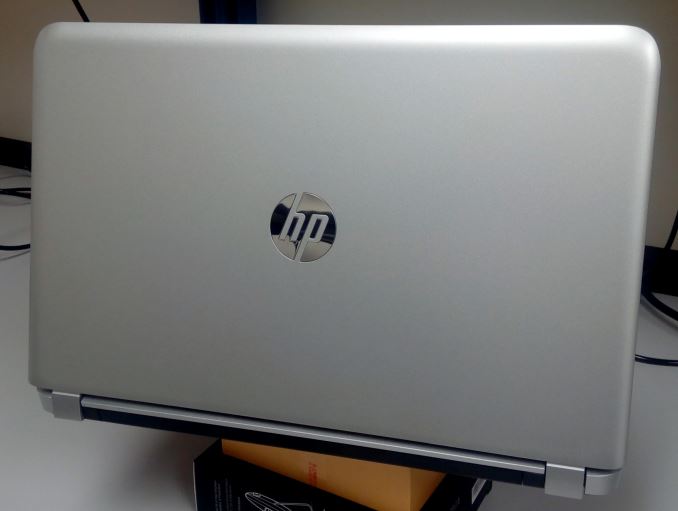






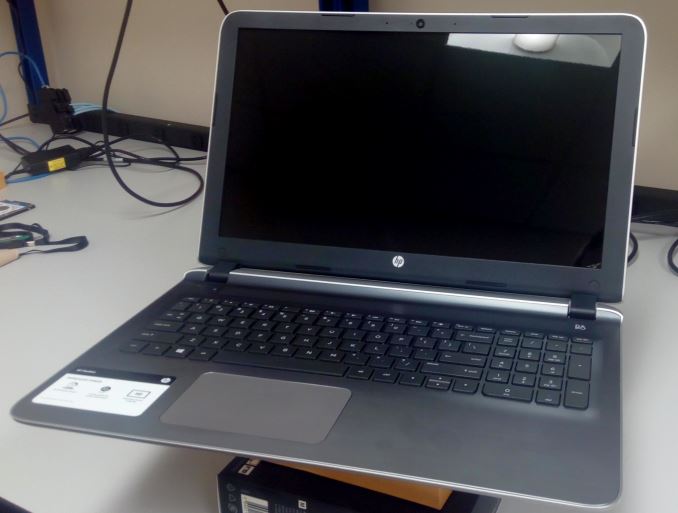
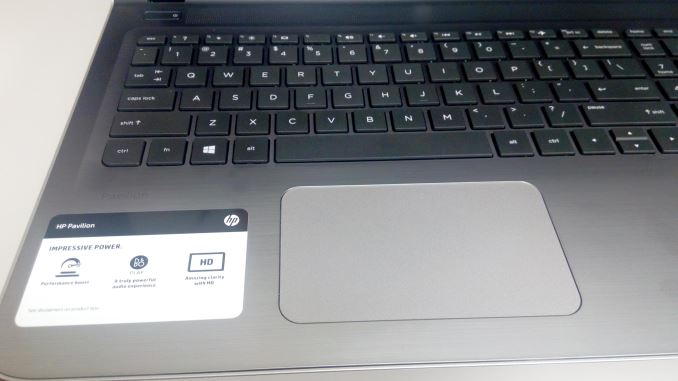
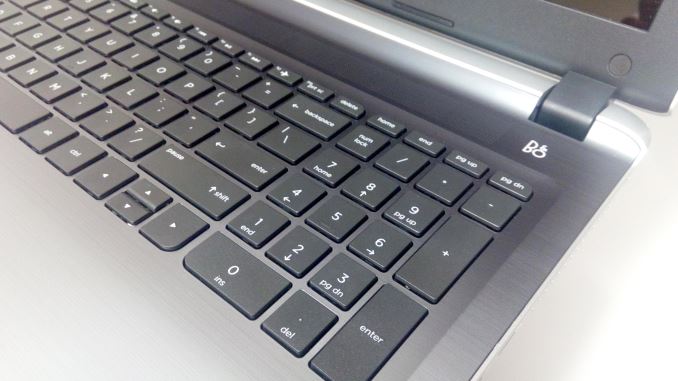


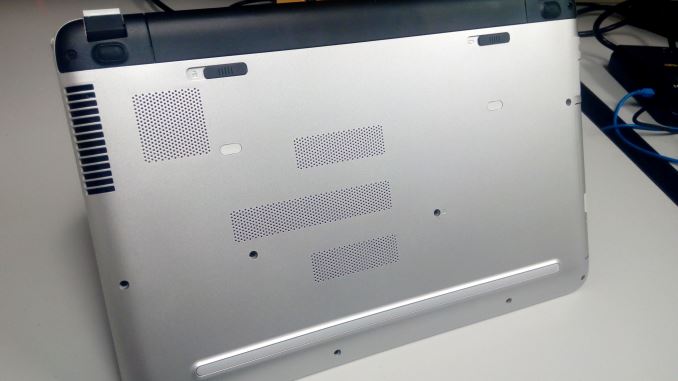
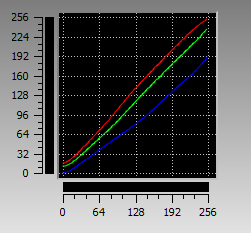

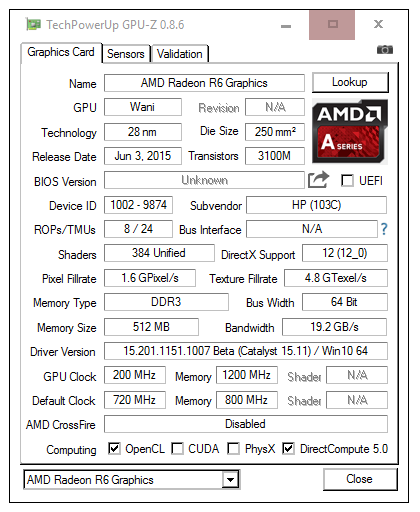
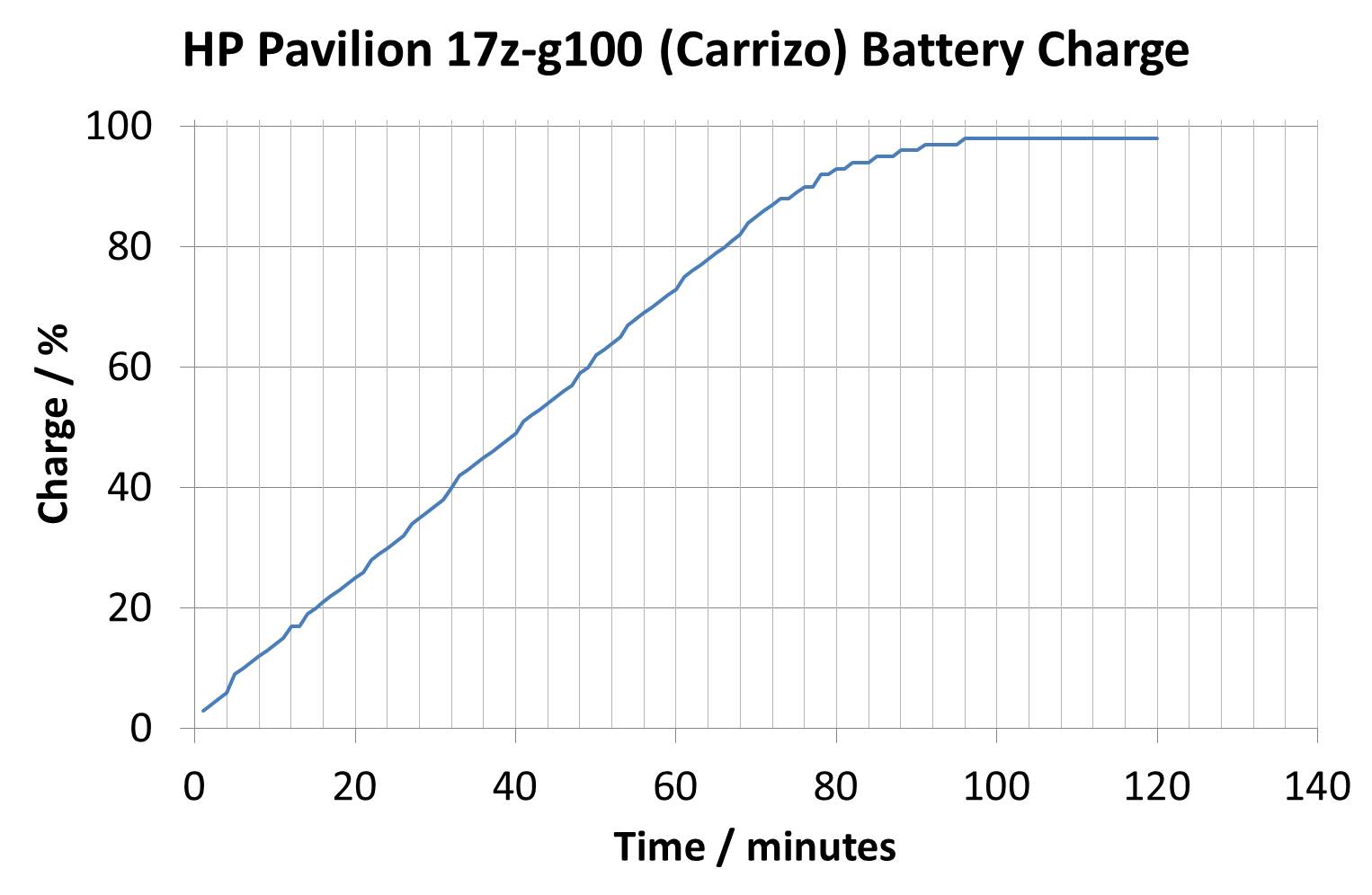








175 Comments
View All Comments
Squinoogle - Saturday, February 27, 2016 - link
An interesting read. I'll say I'm glad you went to the bother even if the ends weren't quite what you were expecting from the outset.I agree that it would be quite interesting to see someone make a proper halo device to showcase Carrizo at its best, rather than the trend of taking an established Intel chassis and then stuffing a hobbled AMD configuration inside it.
Speaking of which, I had a look at the HP UK website since I remembered seeing exactly that situation in the past (was an Envy 15 model that time) and came across an interesting trio of devices:
Three models from the Pavilion Black Edition range, all three using the same chassis and internal components, the only difference being the wifi card on the A10 model is upgraded.
http://store.hp.com/UKStore/Merch/Product.aspx?id=... - Core i3-6100U £459
http://store.hp.com/UKStore/Merch/Product.aspx?id=... - A10-8780P + R7 M360 £529
http://store.hp.com/UKStore/Merch/Product.aspx?id=... - Core i5-6200U £549
I'd be interested in seeing a true apples-to-apples comparison between devices like these, where the Intel and AMD models are priced and specified so closely together.
Gc - Sunday, February 28, 2016 - link
Another Carrizo 'capability' not implemented:Carrizo was advertised as the first architecture to support full HSA 1.0, but ...
Can any retail Carrizo systems run HSA?
As I understand, to run HSA currently requires installing Linux and the HSA driver.
(Possible running the HSA Docker container on this host, but the host must have the HSA driver.)
https://github.com/HSAFoundation/HSA-Docs-AMD/wiki...
https://github.com/HSAFoundation/HSA-Drivers-Linux...
The only test system listed is a "A88X-PRO" desktop motherboard and Kaveri "A10-7850K" APU.
(No Carrizo chips are available for that socket.)
The host must have "the IOMMU enabled in the BIOS".
This is the IOMMU of the GPU, typically under Graphics Configuration in the BIOS.
https://community.amd.com/thread/169962
However, I have not seen any retail Carrizo systems that implement that BIOS option. Do they exist? (The closest thing is the option to enable AMD-V as required for Docker, but that is not the same thing, as the above link indicates.)
If not, why not? (Is an effort/investment needed to get the support into common AMD chip BIOS/UEFIs used by ODMs, similar like it was needed to get support into the Linux kernel?)
albert89 - Wednesday, March 23, 2016 - link
Although I congratulate Anandtech after repeated demands from consumers like myself as to why a review of Carrizo wasn't done sooner the result is a review that leaves one ask many questions and a demand for another review since new info has come to light.So redo the whole review under dual channel conditions for AMD's Carrizo. Otherwise you'll be leaving this review incomplete and short changing a competitor of Intel leaving us to wonder how bias Anandtech is towards AMD !
DJ Dave - Saturday, March 25, 2017 - link
hey.i just bought this as a refurb. it seems to lag/stutter with certain programs. Mine has 2 ram slots with 4gb in each..does anyone know if that can be upgraded?krissh6563 - Sunday, August 9, 2020 - link
Sir I have Hp Elite-book 745 G2 laptop. Now I am facing overheating problem in my laptop. So what should I do.